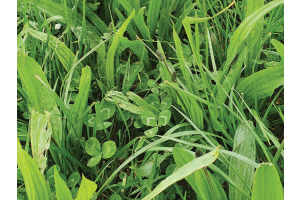The Benefits of Multi-Species Grass Seeds

Harvesting season is just around the corner and the talk on most farmers’ lips is all about grass. The weather hasn’t been kind and means dairy, beef and sheep farmers are potentially looking at a deficit this year. However, multi-species grass seeds are providing an alternative to disappointing yields.
Multi-species swards are making a lot of noise in the farming community. They need less resources and are much better for the livestock. The previous misconceptions about them only being suitable for drier climates have been put to bed by Teagasc.
If multi-species are the way forward, it’s time for farmers, merchants, agricultural advisors and policy makers to start paying more attention.
What are the benefits of a multi-species grass sward?
Multi-species grass has been an area of huge focus in many of the latest Teagasc studies. They are doing their best to give farmers every advantage in an increasingly restricted environment. As farmers continue to grapple with the changing climate and customer demands, multi-species grass is providing serious benefits.
1. Reduced Need for Inorganic Nitrogen
One of the crowning improvements that multi-species grass holds over perennial ryegrass monocultures is its ability to produce more with less.
Teagasc research found that multi-species can maintain a high yield with hugely reduced inorganic nitrogen fertiliser. While it takes some grass swards 300kg+, a well-maintained multi-series sward can get by without any because many of the legumes provide fertiliser naturally. With farmers at the mercy of the market when it comes to fertiliser prices, this is welcome news.
Brexit and a higher nitrogen demand than usual coming from the US amidst the reduction in supply are causing prices to fluctuate massively. When this is added to the chastening EU regulations that are not about to change, the option of a reduced reliance on N is increasingly attractive.
1. Increased Sward
Martin Heaney of Merrywell Farm has been a McGuinness seed customer for years now. He has been using multi-seed on a few paddocks for 3 years after initially discovering it on a business trip to South Africa where it is commonplace.
After consultation with Teagasc and Tom McGuinness, he decided to give it a try. Since making the switch, Mr. Heaney has gotten an average of 1 ton per hectare more from multi-seed according to pasture base.
His sward would confirm the findings of the 2018 Teagasc study based in Johnstown Castle. They found a six-species sward produced 1.3 tons more of dry matter yield per hectare (1T DM/HA) than a hectare of rye grass that required 300kg of Nitrogen.
2. Healthier Animals and Land Produced
Perhaps, the lesser-known outcome of the multi-species sward is the impact it has on the animals but it is worth paying attention to.
Multi-species use a blend of grasses, herbs and legumes. It is this variety of different vitamins, minerals and nutrients that creates a more balanced diet for grazing livestock. The herbs and legumes also contain more protein and rich vitamins which help to reduce bloating.
Using multi-seed allows you the flexibility to include traditionally healing and nutrient dense seeds like plantain, yarrow and chicory. Chicory is especially important as it contains a natural anthelmintic which helps to expel any parasites your livestock might pick up.
3. Improved Summer Yields
Ireland could typically be relied upon for year-round rain up to the last five years. Of late, however, the summers have gotten significantly hotter leading to more extreme heat. Unfortunately, this is taking its toll on summer yields.
Multi-species seeds have the advantage of including warm season seeds that don’t succumb to the heat like typical rye grass swards.
Plantain and chicory root much deeper than rye, fortifying it against drought. The inclusion of the warm season multi-species mean farmers are getting a much higher summer yield in the current conditions.
4. Reduced Environmental Impact
Farming is never far from the spotlight when it comes to the climate conversation. Many of the traditional resources are not considered eco-friendly and agriculture is accounting for as much as 10% of emissions in the US.
Something is going to give. While some studies show giving cows seaweed can drastically reduce methane production, this isn’t about to resolve the bigger problems. Multi-species swards, however, could be an answer.
Less nitrogen and slurry requirements are only one environmental benefit. The deeper rooting swards also greatly improves on carbon sequestration. Sequestration is the process of capturing the carbon dioxide in the atmosphere which is a huge area of focus for the UN’s Paris Accord.
When this is added to the reduced N and the increased biodiversity for natural pollinators like bees, there is cause for optimism. Multi-species could well be the opportunity for farmers to go from bearing the brunt of the conversation to leading it.
Conclusion
Farmers are coursing through a challenging time at the minute. Grass sward yields are less predictable and costing more to produce. The consistent climate change conversation puts every agricultural employee in precarious territory as new regulations are threatening livelihoods.
Multi-species grass seeds are far from the elixir but they are a huge step in the right direction. They are giving farmers better yields more efficiently. It means less time and money are spent on fertilizing with pricey nitrogen.
Most of all though, the farmers are given a chance to take more control in their businesses. Instead of absorbing EU and government regulations, multi-species offers a chance at greater productivity in an environmentally friendly way. A win win for all stakeholders.





